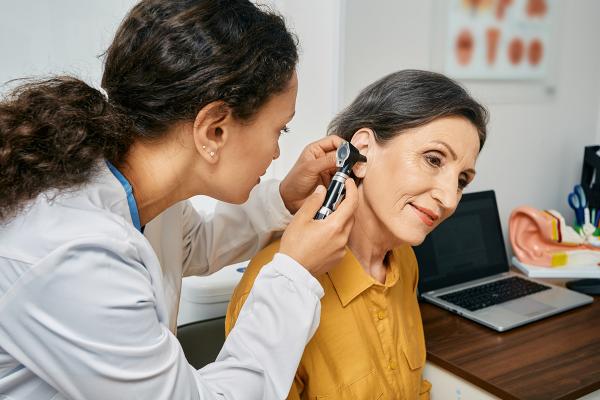
EPIC Hearing Healthcare helps members access hearing exams, hearing aids and more. Sign in to learn more and check eligibility.
No, ear infections aren’t just for children. Adults get them too, and an infection may make it harder to hear. Read on for the facts you need to know.

If your ears hurt or you have trouble hearing, you might not suspect you have an ear infection at first. That’s no surprise. Children are much more likely to get ear infections than adults.1
For one thing, in kids the narrow tubes that connect the middle ear to the back of the throat don’t work as well. (These tubes, called eustachian tubes, help fluid drain from the middle ear.2) Plus, children’s immune systems aren’t developed yet, so they have a hard time fighting off bacteria and viruses that cause infection.1
But adults sometimes get ear infections too, usually in the middle ear, says Matthew Kim, M.D. He’s an ear, nose and throat (ENT) specialist with Summit Health in New York City. They may be just as painful as the ones kids get. And they can also affect how well you hear. “Temporary hearing loss is one of the most common symptoms of a middle ear infection,” says Dr. Kim.
To find out the basics about ear infections in adults, read on.

EPIC Hearing Healthcare helps members access hearing exams, hearing aids and more. Sign in to learn more and check eligibility.
Ear infections are caused by viruses or bacteria, according to the Mayo Clinic.3 There are 3 types. Each infection affects a different part of the ear.
Middle ear infections (also called otitis media): The middle ear is the air-filled space behind the eardrum. Middle ear infections are usually caused by a cold or other respiratory infection.3 Allergies or chronic sinus infections can occasionally cause them too, says Dr. Kim.
The bacteria or virus goes into the eustachian tubes, causing them to become inflamed and swell.1 Eventually, these swollen tubes become blocked and filled with fluid. That sets up a breeding ground for more bacteria to grow.
Inner ear infections (also called otitis interna): These are most often caused by a virus, including the flu but sometimes also the same virus that causes shingles.4 They’re also caused when an infection in the middle ear spreads to the inner ear. And this type of ear infection is more common in adults than children, according to the Cleveland Clinic.4
Outer ear infections (also called otitis externa or swimmer’s ear): This is an infection of the ear canal, explains Dr. Kim. Typically, people get swimmer’s ear from water exposure, either from swimming or even just from bathing.5 It happens when moisture in the ear canal allows bacteria (and sometimes fungus) to grow. Another cause? A cut or damage to the skin in your ear from a cotton swab or fingernail.6
One of the main symptoms is trouble hearing. While this may not always be the case with swimmer’s ear, it’s typically true of middle ear infections, says Dr. Kim. Luckily, the hearing loss from swimmer’s ear or a middle ear infection is temporary, he adds.
That isn’t the case for inner ear infections. If they are not treated, they can cause partial or permanent hearing loss.5
Other symptoms of ear infections include:3,4,5
People with an inner ear infection might also notice:4
“Balance issues can occur in people of all ages with an ear infection but probably occur more commonly in the elderly,” says Dr. Kim. This may be because of certain medications they are taking or other medical conditions, he adds.
It’s always a good idea to treat ear infections, especially in adults. If you suspect you have one, call your primary care provider or an ENT to get a diagnosis. Sometimes a provider will take a wait-and-see approach for a day or two, says Dr. Kim. “But if you do not treat a middle ear infection, it could lead to complications.”
The most common way to treat middle and outer ear infections is with antibiotics. These include oral medications for middle ear infections and antibiotic drops for swimmer’s ear, says Dr. Kim. You’d take the antibiotics for 7 to 10 days, he adds.
Sometimes doctors prescribe antibiotics or antivirals for inner ear infections.4 But most often they use steroids to relieve inflammation. You might also get antihistamines to relieve dizziness or anti-nausea medications.4
As you wait for the antibiotics to kick in, you can take over-the-counter pain relievers. These include acetaminophen and ibuprofen.
It’s normal for some hearing loss to linger as you treat an ear infection. But if it continues for more than a week or two after your infection is gone, you may need to see an ENT, says Dr. Kim. They can make sure your infection is gone and check for any damage to your ear, such as a ruptured eardrum.
If the infection has gone away and you still have trouble hearing, it may be time for a comprehensive hearing exam with a hearing care professional. Then you’ll be able learn whether your hearing loss is from an ear infection or something else.
Did you know that many benefits, including a hearing exam and consultation, are covered through EPIC Hearing Healthcare? Learn more.
Sources
Information is for educational purposes only and is not a substitute for the advice of a licensed medical provider. Consult your provider prior to making changes to your lifestyle or health care routine.